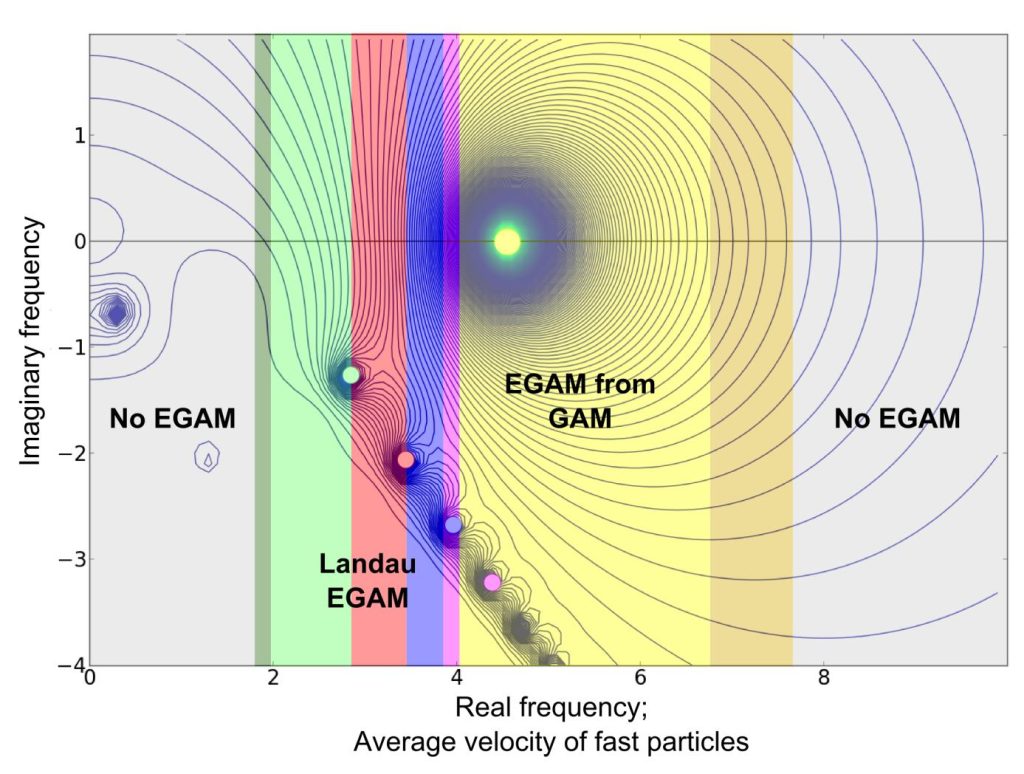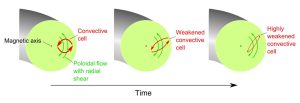Turbulence is a major issue in tokamaks, in particular as it drives energy from the core of the plasma to the edge of the plasma. This undesired energy transport is one of the elements which account for the difficulty of maintaining fusion-favourable conditions in the heart of tokamaks. The introduction of a specific perturbation (EGAM) could contribute to reduce turbulence.
Various ways of reducing turbulence are being explored.
One of the investigated paths consists in introducing on a large scale (tokamak scale) a poloidal flow with radial velocity shear, as a perturbation which comes in superposition to the equilibrium plasma. This perturbation (also called mode) is characterized by an oscillation frequency. Two kinds of perturbations, each corresponding to a range of oscillation frequencies, are currently being studied:
- low frequency perturbations, called zonal flows. Those perturbations seem to have a positive, weakening impact on turbulence; but they are unfortunately difficult to generate on purpose;
- high frequency perturbations, called GAMs (Geodesic Acoustic Modes). This name was given to those perturbations because of their origin (geodesic curve of the plasma) and their frequency (close to the frequency of acoustic waves in the plasma). Like zonal flows, GAMs seem to have a positive, weakening impact on turbulence but are difficult to generate on purpose.

Since years 2000, modes close to GAMs have been observed in various tokamaks: their frequencies are slightly different from that of the GAMs but of the same order of magnitude, the poloidal and toroidal structures are the same, the radial structures are different. Those modes have been called EGAMs (Energetic particle driven GAM), for they are excited by fast particles when favourable conditions are met. A way of generating those fast particles is through Ion Cyclotron Resonance Heating (ICRH), which makes it possible, to some extent, to control the EGAMs.
Today, the capability of EGAMs to control turbulence is still to be confirmed. To this purpose, it is worth studying the link between GAMs and EGAMs. Depending on the equilibrium parameters of the plasma and the fast particles, GAMs and EGAMs appear to be more or less close to each other. A first set of diagrams showing the link between them as a function of the relevant parameters has been established; those diagrams show that there exist some regions in which EGAMs are particularly close to GAMs. In those regions, EGAMs are more easily excited; and because of the strong link with GAMs, hopes are that turbulence reduction will there be enhanced. Studies will now be focused on that last point.
“Relation between energetic and standard geodesic acoustic modes“
Jean-Baptiste Girardo, Rémi Dumont, Xavier Garbet, Yanick Sarazin, Sergei Sharapov
Phys. Plasmas 21, 092507 (2014)
http://scitation.aip.org/content/aip/journal/pop/21/9/10.1063/1.4895479



